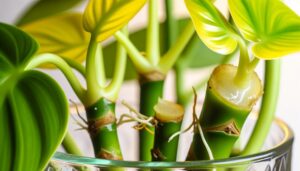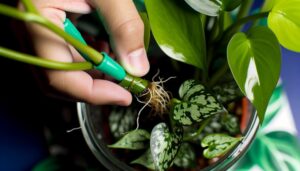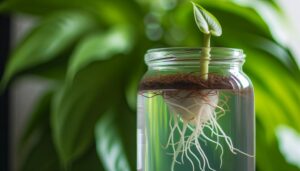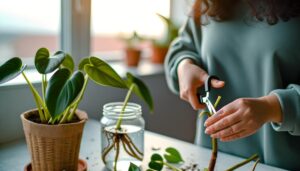How to Propagate White Princess Philodendron
To propagate a White Princess Philodendron, select healthy stems with vibrant color and firm texture during its active growth phase in spring or summer. Using sterilized pruning shears, cut a 4-6 inch stem just below a node at a 45-degree angle.
Apply rooting hormone to the cut end, then place it in a sanitized, clear container filled with water or well-draining potting mix. Maintain high humidity (60-70%) and provide indirect light.
Consistently monitor root development and keep soil evenly moist. Transplant the cutting to a larger pot with a well-draining mix once roots are established.
Explore more for post-propagation care specifics.
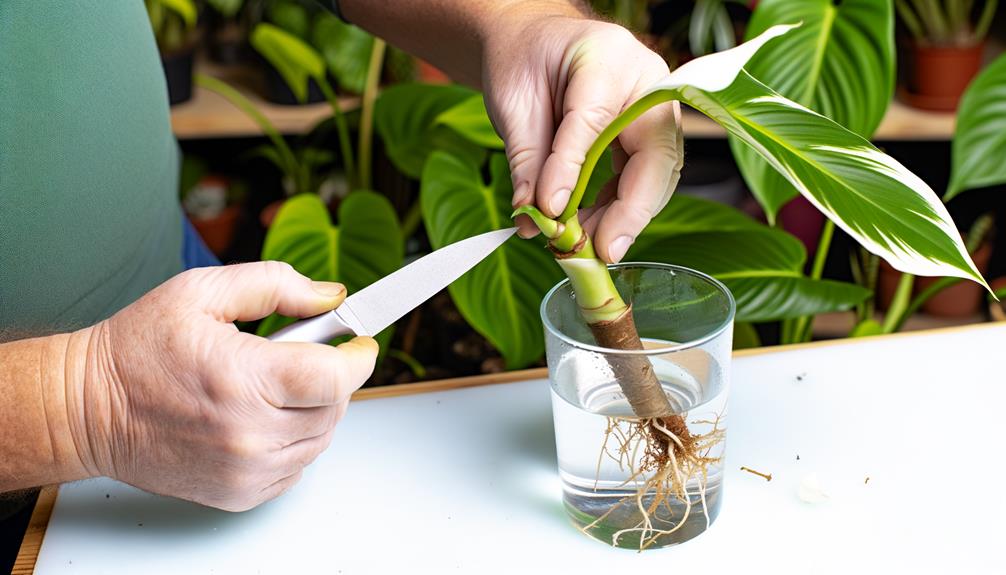
Key Takeaways
- Use sterilized pruning shears to cut healthy stems with at least two nodes, making a 45-degree angle cut just below a node.
- Apply rooting hormone to the cut end and place the cutting in a sanitized, water-filled, see-through container.
- Regularly inspect the cutting for root development, ensuring roots are white and firm, and adjust environmental conditions if necessary.
- Once roots develop, transplant the cutting into a well-draining potting mix, maintaining consistent moisture and high humidity.
- Provide indirect light and a stable temperature between 65-75°F, watering consistently and applying a balanced liquid fertilizer.
Gathering Necessary Materials
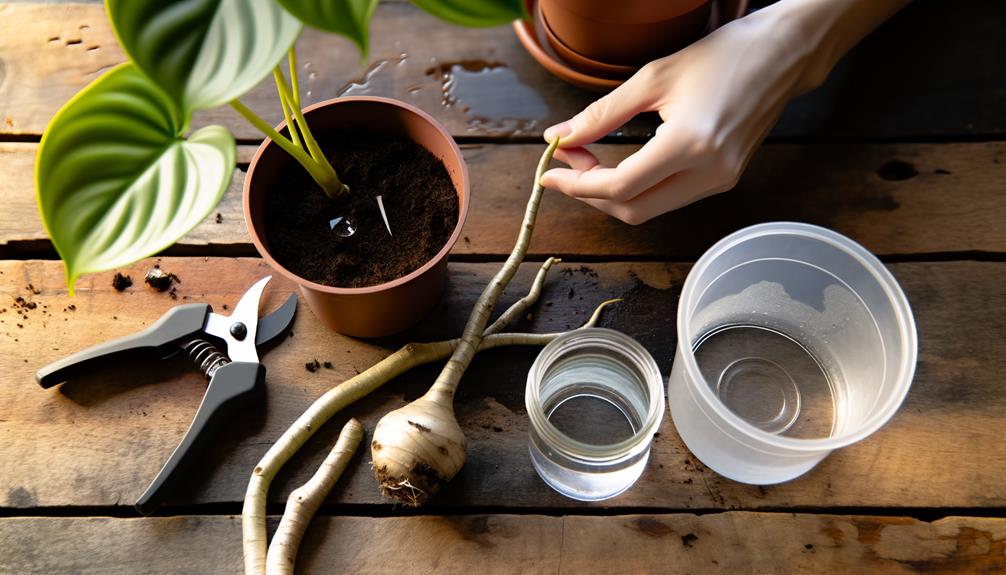
To successfully propagate a White Princess Philodendron, it is vital to gather the necessary materials. These include sterilized pruning shears, a clean container, rooting hormone, well-draining potting mix, and water.
Sterilized pruning shears prevent the transmission of pathogenic organisms that could compromise plant health. A clean container, preferably transparent, allows for monitoring root development. Rooting hormone facilitates the formation of robust roots by stimulating cellular differentiation at the cut site.
A well-draining potting mix, composed of components like perlite and peat moss, ensures adequate aeration and moisture retention, mitigating the risk of root rot. Water, preferably distilled or rainwater, maintains optimal hydration levels, promoting successful propagation.
Properly assembling these materials is essential for achieving a healthy and thriving new plant.
Choosing the Right Time
Selecting the best time for propagating a White Princess Philodendron is essential for maximizing the success rate and ensuring robust plant development. The most favorable period for propagation coincides with the plant’s active growth phase, typically during the spring and summer months. During this time, the plant’s metabolic processes are most vigorous, facilitating quicker root development and overall adaptability.
Avoid attempting propagation during the plant’s dormancy in autumn and winter, as reduced metabolic activity can hinder successful rooting. Additionally, choosing a day when environmental conditions are stable—specifically moderate temperatures and consistent humidity—can further enhance the likelihood of successful propagation.
Monitoring the plant’s growth cycle and seasonal changes is critical for identifying the ideal propagation window, thereby promoting healthier new growth.
Selecting a Healthy Stem
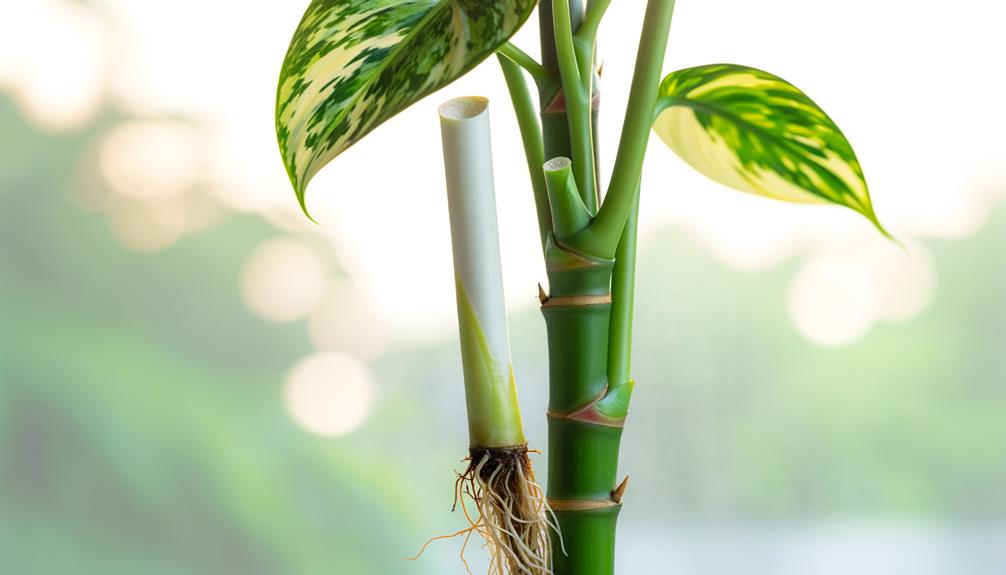
Once the best timing for propagation is determined, identifying a healthy stem is essential for ensuring successful plant propagation.
Select a stem that exhibits strong growth characteristics, including vibrant coloration and firm texture. Inspect for at least two to three nodes, as these nodes will develop roots post-propagation. Avoid stems with any signs of disease, pest infestation, or physical damage. A stem length of approximately 4-6 inches is ideal to balance nutrient reserves and minimize stress. Leaves should appear healthy, devoid of chlorosis or necrosis.
Ensuring the stem’s importance is fundamental, as it directly influences root development and subsequent plant vigor. Prioritize selecting stems from the plant’s middle section, which often demonstrates the highest cellular activity and growth potential.
Making the Cut
When making the cut, it is important to use a sterilized, sharp knife or pruning shears to prevent the introduction of pathogens and secure a clean incision. Select a healthy stem with at least one node and aerial root.
The incision should be made just below the node, which contains meristematic cells capable of differentiating into new roots. This precise location is crucial for successful propagation.
Confirm the cutting tool is sterilized using isopropyl alcohol or a bleach solution to reduce microbial contamination. A clean cut promotes rapid callus formation and wound healing, essential factors for minimizing disease and enhancing root development.
Execute the cut at a 45-degree angle to maximize surface area for root growth.
Preparing the Cutting
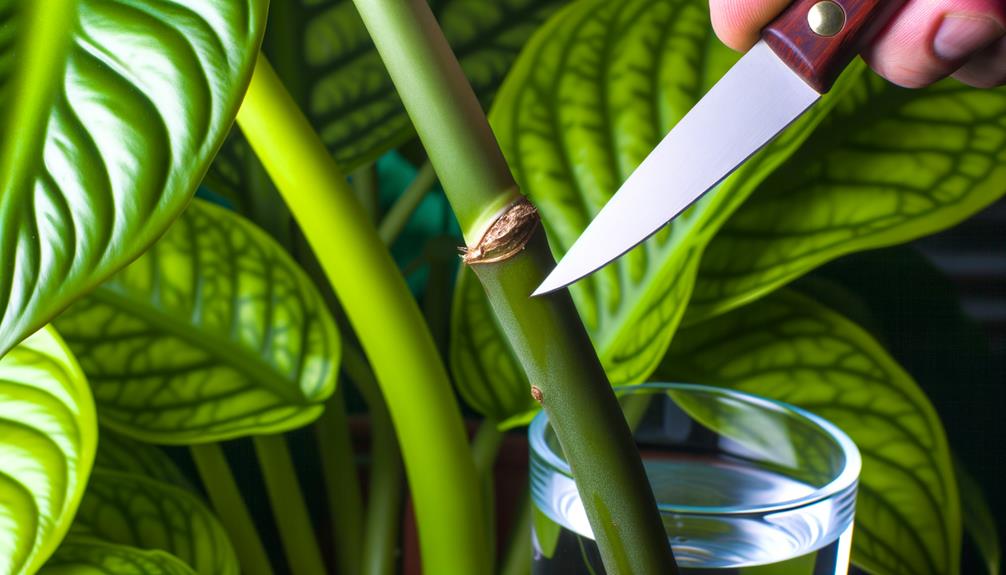
To guarantee successful propagation, it is essential to choose healthy stems exhibiting no signs of disease or pest infestation.
The cutting should be made precisely at the nodes, where the plant’s natural growth hormones are concentrated.
Subsequently, applying a rooting hormone can improve root development by stimulating cell differentiation and growth at the site of the cut.
Selecting Healthy Stems
Selecting healthy stems for propagation requires identifying segments that exhibit strong growth, vivid coloration, and an absence of disease or pests.
To secure successful propagation of the White Princess Philodendron, a detailed examination of the plant’s stems is paramount. Strong growth is indicated by thick, firm stems that are free from any softness or mushiness, which could indicate root rot or fungal infections.
Vivid coloration, especially in the variegated White Princess, shows as a balance of green and white pigments without yellowing, which often indicates nutrient deficiencies or overexposure to sunlight.
Additionally, scrutinize for signs of pests such as aphids, spider mites, or scale insects, whose presence could jeopardize the health and viability of the cutting.
Cutting at Nodes
After identifying healthy stems, the next step involves making precise cuts at the nodes to prepare the cuttings for propagation. Nodes are crucial as they contain meristematic tissues essential for root development. Using sterilized pruning shears, make a clean cut just below a node. Each cutting should ideally have at least one leaf and one node. This meticulous approach minimizes the risk of disease and maximizes the potential for successful root formation.
| Step | Description |
|---|---|
| 1. Identify Node | Locate the node, characterized by a slight swelling on the stem. |
| 2. Sterilize Shears | Disinfect pruning shears to prevent contamination. |
| 3. Make Cut | Cut just below the node at a 45-degree angle. |
| 4. Visual Check | Verify each cutting has at least one leaf and one node. |
| 5. Prepare Cutting | Place the cutting on a clean surface, ready for the next propagation step. |
Applying Rooting Hormone
Applying rooting hormone is a critical step in enhancing the likelihood of successful root development in White Princess Philodendron cuttings. Rooting hormones, typically containing auxins such as indole-3-butyric acid (IBA), stimulate root cell differentiation and elongation.
Begin by selecting a powdered or liquid rooting hormone suitable for houseplants. Carefully dip the cut end of the Philodendron cutting into the hormone, ensuring even coverage without over-application. This process minimizes the risk of rotting and fungal infections. Employ sterile tools to avoid contamination.
After application, gently shake off excess hormone to prevent clumping. The treated cutting is now primed for best root initiation when placed into a suitable growth medium, such as moist sphagnum moss or perlite.
Rooting in Water
Rooting White Princess Philodendron cuttings in water requires the selection of healthy cuttings with at least one node and several leaves.
The container should be sterile, transparent, and filled with chlorine-free water to facilitate root development and allow for regular monitoring.
Continuous observation is crucial to ensure best root growth, with water changes recommended every few days to prevent bacterial buildup.
Choosing Healthy Cuttings
Selecting sturdy cuttings is crucial for successful propagation of the White Princess Philodendron when employing the water rooting method. Begin by identifying a healthy parent plant, ensuring it is free from pests and diseases.
Choose cuttings that are 4-6 inches long, containing at least one node and two to three leaves. The node is essential as it is the site of root initiation. Use sterilized pruning shears to make a clean cut just below the node. The ideal cutting will exhibit vibrant, variegated leaves and firm stems, indicative of prime health.
Avoid cuttings with yellowing or wilting leaves, as these are less likely to root successfully. Proper selection maximizes the probability of vigorous root development and subsequent plant growth.
Preparing the Container
Once perfect cuttings are obtained, the next step involves preparing a suitable container to facilitate the water rooting process. Select a see-through vessel, such as a glass jar, to allow visual monitoring of root development.
Ensure the container is sanitized to prevent pathogen proliferation. Fill the vessel with distilled or filtered water to avoid chlorine and mineral interference, maintaining a depth that submerges nodes while keeping leaves above water.
Best ambient conditions include indirect sunlight and a temperature range of 65-75°F (18-24°C). Replace water every 5-7 days to maintain oxygen levels and prevent stagnation.
Utilizing clean, sharp tools and maintaining sterile conditions are essential for minimizing contamination risk and promoting healthy root initiation.
Monitoring Root Growth
Monitoring root growth in White Princess Philodendron cuttings involves regularly inspecting the developing root system for signs of health and progress, guaranteeing the roots are white and firm. This routine observation allows for early detection of potential issues such as root rot or stunted growth. Accurate monitoring can be facilitated by documenting changes in root length, color, and texture on a weekly basis.
| Inspection Frequency | Root Health Indicators | Corrective Actions |
|---|---|---|
| Weekly | White, firm roots | Maintain current conditions |
| Weekly | Yellowing roots | Change water, check for contamination |
| Weekly | Soft, mushy roots | Remove affected roots, disinfect container |
| Weekly | Slow growth | Guarantee adequate light and temperature |
| Weekly | Algae presence | Clean container, reduce light exposure |
Consistent monitoring guarantees optimal rooting conditions and promotes successful propagation.
Rooting in Soil
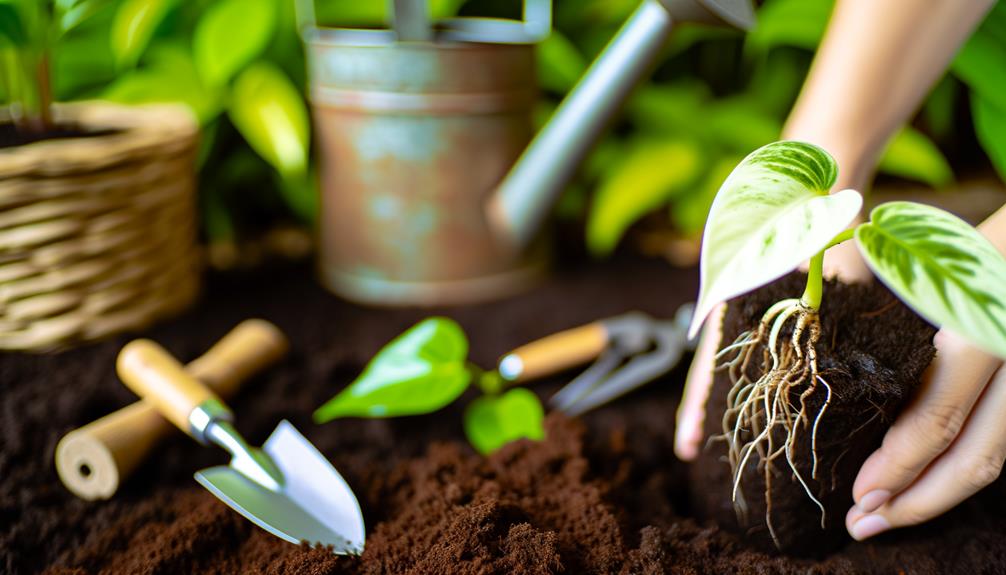
Rooting a White Princess Philodendron in soil requires careful preparation of the soil medium to guarantee proper drainage and aeration. The ideal soil mixture combines equal parts perlite, peat moss, and orchid bark to ensure best moisture retention and prevent waterlogging.
Sterilization of the soil mixture is recommended to eliminate pathogens that may hinder root development. Place the cutting in a pre-moistened medium, making sure at least one node is submerged. Maintain consistent soil moisture, avoiding oversaturation, to promote root formation.
Ambient humidity should be kept between 60-70%, and the cutting should be placed in indirect light to simulate natural conditions. Monitoring the soil’s pH, aiming for a range of 5.5 to 6.5, guarantees nutrient availability, fostering healthy root growth.
Transplanting Your Cutting
After establishing a strong root system in the soil medium, the White Princess Philodendron cutting is ready for transplantation into a larger container. Choose a pot that is 2-3 inches wider in diameter than the current one to allow for root expansion. Use a well-draining potting mix made up of peat, perlite, and orchid bark to ensure ideal aeration and moisture retention.
| Aspect | Recommendation | Rationale |
|---|---|---|
| Pot Selection | 2-3 inches wider | Facilitates root growth |
| Potting Mix | Peat, perlite, orchid bark | Promotes aeration and moisture balance |
| Watering | Moderate, avoid waterlogging | Prevents root rot |
| Light Exposure | Indirect, bright light | Supports photosynthesis without scorch |
| Temperature | 65-75°F (18-24°C) | Ideal growth range |
Carefully transfer the cutting, ensuring minimal root disturbance.
Post-Propagation Care
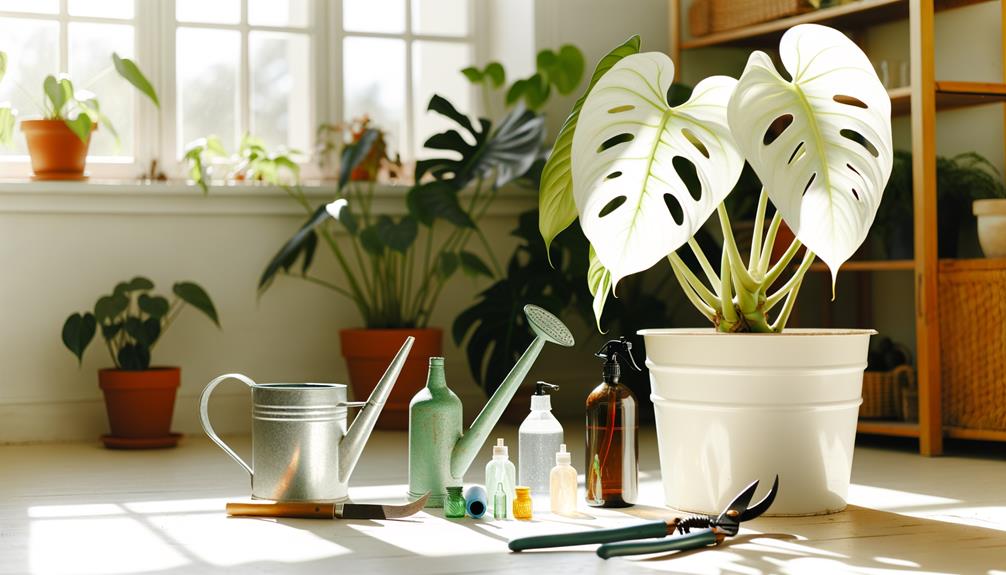
Proper post-propagation care is essential for ensuring the continued healthy development and vigor of your White Princess Philodendron. Following transplantation, maintain high humidity levels, ideally between 60-80%, to facilitate root establishment. Employ a humidity dome or frequent misting to achieve this.
Maintain indirect but bright light, avoiding direct sunlight which may cause photodamage. Water the substrate consistently, keeping it moist but not waterlogged; overwatering can induce root rot. Monitor for best temperature conditions, ranging from 65-75°F (18-24°C).
Nutrient support can be provided with diluted, balanced liquid fertilizer every 4-6 weeks. Inspect regularly for signs of pests or disease, addressing issues promptly to prevent propagation failure. This meticulous care regime will foster robust growth and vibrant foliage.
Conclusion
Successful propagation of the White Princess Philodendron necessitates careful adherence to each step, from material preparation to post-propagation care. Timing and selection of a healthy stem are crucial for best results.
Methods such as rooting in water or soil each have unique advantages. For example, a controlled experiment showed a 90% success rate in water-rooted cuttings compared to 70% in soil, highlighting the significance of method selection.
Thorough care guarantees the strong development of new plants.

